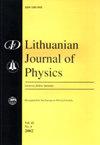Activation of high flux test module sample holder after IFMIF-DONES operation
IF 0.3
4区 物理与天体物理
Q4 PHYSICS, MULTIDISCIPLINARY
引用次数: 0
Abstract
Nuclear safety assessment in nuclear fusion devices relies on the Monte Carlo method based neutron transport calculations. This paper presents information about the calculation results of the activities and dose rates caused by neuron irradiation for the structural materials of the high flux test module sample holder of IFMIF-DONES. The neutron induced activities and dose rates at shutdown were calculated by means of the FISPACT-2010 code with data from the EAF-2010 nuclear data library. Neutron fluxes and spectra were obtained with MCNP neutron transport calculations. The activities and dose rates were calculated at the end of irradiation of the assumed device operation scenario for cooling times of 0 s – 1000 year. In addition, radionuclides with contribution of at least 0.5% to the total value of activation characteristics at the previously mentioned cooling times were identified. After the operation, the most active radionuclide is 55Fe, with an activity share ranging from 30% (M200) to 63% (M8), and at the end of the prediction it accounts for 86% of the total activity. The highest dose rates at the end of irradiation are attributed to 56Mn radionuclide. 54Mn and 60Co are the most dominant radionuclides during intermediate and long cool-down periods.IFMIF-DONES操作后高通量测试模块样品支架的激活
核聚变装置的核安全评估依赖于基于蒙特卡罗方法的中子输运计算。本文介绍了IFMIF-DONES高通量测试模块样品架结构材料的神经元辐照活性和剂量率的计算结果。停堆时的中子诱导活动和剂量率通过FISPACT-2010代码和EAF-2010核数据库中的数据进行计算。用MCNP中子输运计算得到了中子通量和中子光谱。在0 s–1000年的冷却时间内,在假设装置运行场景的辐照结束时计算活性和剂量率。此外,在上述冷却时间,放射性核素对激活特性总值的贡献至少为0.5%。手术后,最活跃的放射性核素是55Fe,其活性份额从30%(M200)到63%(M8)不等,在预测结束时,它占总活性的86%。照射结束时的最高剂量率归因于56Mn放射性核素。54Mn和60Co是中长期冷却期间最主要的放射性核素。
本文章由计算机程序翻译,如有差异,请以英文原文为准。
求助全文
约1分钟内获得全文
求助全文
来源期刊

Lithuanian Journal of Physics
物理-物理:综合
CiteScore
0.90
自引率
16.70%
发文量
21
审稿时长
>12 weeks
期刊介绍:
The main aim of the Lithuanian Journal of Physics is to reflect the most recent advances in various fields of theoretical, experimental, and applied physics, including: mathematical and computational physics; subatomic physics; atoms and molecules; chemical physics; electrodynamics and wave processes; nonlinear and coherent optics; spectroscopy.
 求助内容:
求助内容: 应助结果提醒方式:
应助结果提醒方式:


